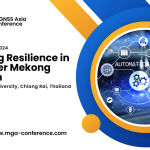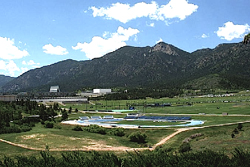
The 2015 edition of the European Navigation Conference (ENC) in Bordeaux last week found the continent’s GNSS community leaving troubles behind and looking to the future, where the world’s dependence on GNSS is greater, the risks higher, and the potential profits ever more tantalizing.
Speaking at the opening session dedicated to “the impact of GNSS on the economic sector,” Topos Cluster President Florence Ghiron answered the question in the simplest of terms: “We expect the GNSS market to grow and to include more and more industrial sectors.”
The 2015 edition of the European Navigation Conference (ENC) in Bordeaux last week found the continent’s GNSS community leaving troubles behind and looking to the future, where the world’s dependence on GNSS is greater, the risks higher, and the potential profits ever more tantalizing.
Speaking at the opening session dedicated to “the impact of GNSS on the economic sector,” Topos Cluster President Florence Ghiron answered the question in the simplest of terms: “We expect the GNSS market to grow and to include more and more industrial sectors.”
The session’s subtitle was “How to promote and accompany the expansion of a downstream European sector in the field of satellite navigation.’ Many will have considered this an appropriate and very useful question to ask. With time moving quickly, as it does, and the Galileo system taking shape, along with new GNSS programs too many to name, all around the world, the Europeans are asking themselves if they are ready to claim their share of the ever-burgeoning GNSS market.
Policy Matters
Axelle Pomies, an engineer with Paris-based consultancy FDC and permanent representation to Galileo Services said, “Don’t forget, part of reason for Galileo is to get market share for Europe.”
By 2023, she noted, the GNSS market will be worth €110 billion, but as of today, Europe still has less than 20 percent of that market cornered, with the largest share by far going to U.S. industry.
“The current window of opportunity will close soon,” Pomies urged. “It will be very difficult for Europe to survive in this highly competitive market.”
But, she added, the game isn’t over. Europe is strong in some sectors, such as road and rail transport, intelligent transport systems, agriculture, autonomous unmanned systems, timing, the Internet of Things, and so forth.
But for a sometimes-timid European private sector, finding the way forward is not likely to be easy. Pomies announced her organization’s support for a European GNSS Industry Policy, to show the way forward and quickly.
Anyone who’s been around Brussels for any amount of time will understand the word “policy” to mean, among other things, “funding” (so, read that as “European GNSS Industry Funding”). Pomies said that Galileo Services plans to release a new position paper on the subject by the middle of May. Conversations during the ENC coffee break indicated that the paper is highly anticipated on both sides of the public/private divide in Brussels.
Fiametta Diani, a market development officer at the European GNSS Agency (GSA), said the European Commission’s first call for research proposals on GNSS “Fundamental Elements,” that is, receiver research, is coming soon. Altogether, over six years, the European Union (EU) has set aside €110 million for research in this area, with most of the money set for release in 2016–17.
Diani also reminded participants that the agency is focused laser-like on the GNSS market. The GSA’s staff includes numerous market experts, she noted. One proof is the recently released and excellent fourth edition of the Agency’s GNSS Market Report.
Bigger and better than ever, the report shows the GNSS devices market growing in all regions of the world. “Europe is not strong in devices,” Diani said, “but we are good in apps, and in the road, rail, and maritime sectors.”
Especially noteworthy, according to the market report, is the growth of multi-constellation receiver manufacturing, with 40 percent of GNSS receivers now being manufactured with Galileo capabilities. Diani justly claimed some credit for the GSA in advancing this trend: “We have managed to support chipset manufacturers and stimulate demand.”
A Long Runway for GNSS Avionics
As far as industry is concerned, whatever help comes will be greatly appreciated.
Speaking for avionics manufacturers, Thales’ Pierre Bouniol considered all of the existing and emerging GNSS programs and projected 2020–2025 as the target period for anyone hoping to cash in on their investments in multi-constellation receiver technologies.
Four frequency bands will be needed to cover all civil signals, he said, while at the same time lower weight and power consumption will remain at a premium. A tough needle to thread, said Bouniol, “A very difficult and expensive task to develop this receiver.”
The role of politics will be crucial, he added, but the right balance will have to be struck, particularly between regulations, standards, and, possibly, mandates.
Alain Boucher of Dassault Aviation, discussing the new generation of aircraft with multi-GNSS-enabled avionics, said, “We need to see a clear path to operational deployment — and while we are making these new airplanes we also have to sell them to our customers, and we have to explain to them why they should buy them. They want to see a clear operational benefit and they want to know when they will see it.”
Aviation consultant Pierre Gayraud noted, “It is always difficult and never easy to implement new equipment in civil aviation — safety is above all other constraints, but on top of this we need global interoperability, uniformity: 190 countries, every country in the world, need to agree.”
The chicken-and-egg problem plays into the equation. Benefits in operational terms only begin to be seen when a large number or percentage of aircraft are equipped; so, early investors know they will see a later return, which discourages those investors, slowing the whole process down.
PNT Resilience
The question of standards carried over to Day 2 of the conference, during a roundtable discussion around the question of positioning/navigation/timing (PNT) resilience. Michel Monnerat of Thales Alenia Space cited problems such as the environment — urban canyons, and indoor scenarios — and threats, including increasing interference and spoofing.
“The solution is multi-constellation and multi-frequency localization, and this is coming,” he said, “and, second, there is the full hybrid solution — the GNSS receiver is no longer alone in the universe. There are signals all around you that can be taken into account and merged to give you a location.”
Is an authenticated signal the solution? Yes, for spoofing, but not for jamming and environmental factors, said Monnerat.
What about crowd-sourcing–based solutions, where large numbers of receivers contribute to interference mapping? “With this large variety of possible techniques,” Monnerat said, “we need standardization.” The standard, he said, would need to specify levels of integrity and levels of performance for different environments.
Jan Wendel of Airbus DS GmbH, Germany, agreed that standards were needed, but urged a steady approach, warning, “Standards are good, but once in place they can be difficult to change, and if they are flawed they will do more harm than good.”
Wendel was a member of a team of Airbus engineers who won last year’s top prize at the European Satellite Navigation Competition for their development of a low-cost Galileo Public Regulated Service (PRS) receiver targeting public security agencies.
Pseudolites, Yea or Nay?
Also in the context of resilience and spectrum management, Matteo Paonni of the EU’s Joint Research Center broached the touchy subject of pseudolites. The EU is now working closely with the United States, he said, to control the use of in-band pseudolites and limit their potential as a source of interference.
“Outdoor pseudolites are clearly undesirable, while indoor pseudolites could be useful, but only under controlled conditions,” Paonni said. Studies undertaken by the European Conference of Postal and Telecommunications Administrations (CEPT), which seemed to provide support for pseudolites — thus raising concerns and, in some cases, alarm within the GNSS community — were incomplete, Paonni insisted. And, he said, further studies are being undertaken.
Either way, the impetus for introducing pseudolites in the first place remains. “We need back-ups for critical systems,” he said. Pseudolites are just one possible solution, as are mini-atomic clocks, GSM networks, and eLoran. “PNT is too important in today’s society, and the EU and the Member States care.”
Andriy Konovaltsev, a research associate at the Institute of Communications and Navigation of the German Aerospace Center (DLR), agreed. “GNSS alone cannot meet all resilience requirements,” he said. “There is a definite need for aiding systems, perhaps inertial systems and different-frequency systems.”
Need for aiding systems notwithstanding, the European Commission is remaining steady in its commitment to GNSS as a primary localization technology, focusing all of its energies on keeping the Galileo flagship on course and leaving the question of non-GNSS-based tools largely to one side.
Ignacio Fernandez, the EC’s manager and design lead of the Galileo Commercial Service, stressed the work being done within the Galileo program to address resilience. “We understand there is a big need to make GNSS more robust. More than six percent of EU GDP right now already depends on GNSS.”
Fernandez outlined some of the Commission’s new ideas about authentication in a recent Inside GNSS article, in the context of the Galileo Commercial Service.
Momentum regained
One can’t help but feel encouraged to hear the European GNSS community addressing real and pressing issues based on the reality of Galileo. No one in Bordeaux was talking about missed opportunities, damage control, or bad omens — frequent topics at past events. Instead, all the discussion was about getting ready for and how to capitalize on full operational capability now expected in 2020.
With previous mishaps receding in the collective memory, and with eight operational Galileo satellites — of varying utility and capability — now in orbit, morale is high in the EU camp. By all accounts, the EC commissioner for space, Elzbieta Bienkowska, admirably expressed this positive outlook after the successful launch of two new satellites last March, in an address in which she encouraged Europe to take a new pride in its accomplishments.
Florence Ghiron, president the Topos Aquitaine association, recommended a more concerted effort to promote European pride in Galileo. An attention-grabbing advertising campaign might be in order, to create a distinguishable brand name, she suggested, for “E-GNSS,” and a “Galileo Inside” label, aimed at raising public awareness and stimulating user demand for new equipment and apps.
Pride and self-confidence might be among the most important commodities right now, as Europe begins to focus on exploiting the coming multi-GNSS opportunities.
Apart from near-term economic benefits, the EU stands to gain in a more fundamental way, because Galileo has always been about more than just launching navigation satellites, and more than just making money — it has always been about demonstrating the ability of the Union to do something good and to do it right.
Success has a way of drawing popular support, and the EU feels the need for that support, as well as for the commercial advancement of its high-tech industry.





